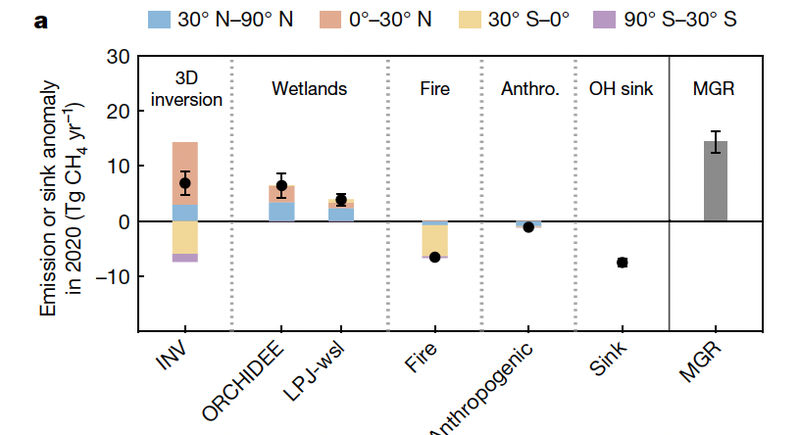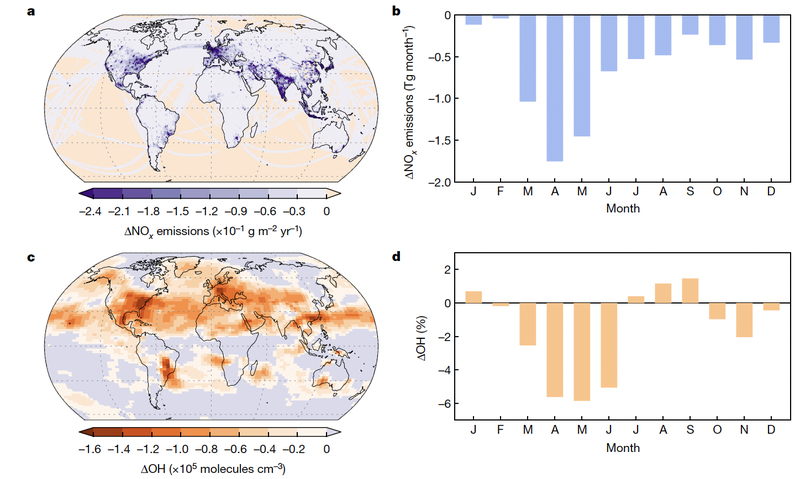25. Januar 2023
Surprise global methane spike during Covid-19 lockdowns investigated
Study identifies wetland emissions and drop in nitrogen oxide as drivers of global anomaly
Levels of atmospheric methane spiked sharply during 2020 despite a drop in emissions from human activity, resulting from global lockdowns imposed during the COVID-19 pandemic. This puzzling observation was reported and studied by researchers working as part of ESA’s Climate Change Initiative in the journal Nature.
They identify a drop in nitrogen oxide emissions and elevated wetland methane as the main contributing factors (figure 1). The results highlight the complex interplay of anthropogenic and natural drivers to the methane budget and has implications for the Global Stocktake.

Methane accounts for 15-35% of the increase in warming from greenhouse gas emissions resulting from human activity. Both in-situ and satellite monitoring show this heat-trapping gas have been accumulating in the atmosphere over recent decades. In 2020 however, the atmospheric methane growth rate (MGR) rose exceptionally, reaching around 15 parts per billion per year – the highest in the 36-year record.
Understanding the drivers behind the methane budget is important for tracking international progress towards successful implementation of anthropogenic methane emissions reduction pledges to limit global warming in line with the UNFCCC Paris Agreement.
The methane peak was surprising considering fossil fuel use fell by 10% according to the International Energy Agency (IEA), leaving scientists initially uncertain to the underlying cause.
To identify the root causes, a research team led by Shushi Peng of Peking University, combined bottom-up and top-down approaches to compare relative changes in methane sources and sinks between 2020 and the previous year. Observations from in-situ and satellite observations, activity data and atmospheric and biogeochemical models were used.
Firstly, a drop in anthropogenic methane emissions in 2020 relative to 2019 were confirmed by the research team. Following interrogation of data sources including the national greenhouse gas inventories submitted to the United Nations Framework Convention on Climate Change (UNFCCC) emissions fell by around 1.2 teragrams or 1,200,000 tonnes per year (Tg CH4 yr−1) across fossil fuel, agriculture and waste.
Fire from biomass burning, an obvious source of natural methane, was ruled out as a contributor. This was confirmed by with two satellite-based datasets (GFAS and GFED4.1) which estimated global fire emissions at approximately 6.5 Tg CH4 yr−1 compared to 2019.
Attention next turned to wetlands – a natural yet and poorly understood natural source of this potent greenhouse gas. According to the researchers, wetland emissions accounted for 47 percent of the 2020 anomaly.
The study shows that regions dominating the world’s wetlands area were exposed to warmer and wetter conditions in 2020 than normal years, with annual rainfall ranging between 2 –11% higher relative to 2019. Along with warmer temperatures, conditions in 2020 were more favourable for methane producing microbes than the previous year. This finding implies higher natural emissions, from wetlands and are sensitive to a warmer and wetter climate and could act as a positive feedback in future.
To account for remaining contributions to the 2020 spike, attention turned to other sources or factors that could influence levels of atmospheric methane. Nitrogen oxide (NOx) was considered a likely candidate.
NOx is known to affect atmospheric concentrations of hydroxyl radicals (OH), which acts as a main sink of methane.
Using fossil fuel combustion data, chemistry transport models and 3D atmospheric models of methane, the team detected a drop in tropospheric OH concentration in 2020. This was due mainly to lower anthropogenic NOx emissions. In turn, global methane removal from reaction with OH decreased by around 7.5 Tg CH4 yr−1, contributing 53 percent of the emissions spike.

This study forms a body of work undertaken by the ESA Climate Change initiative’s REgional Carbon Cycle Assessment and Processes (RECCAP-2) project study which aims to develop robust, observation-based estimates of changes in carbon storage and sinks, regional carbon budgets and provide science-based evidence to address climate change and direct anthropogenic drivers. The project’s recent studies have estimated impacts of land use change and forest degradation on Amazon land carbon sinks and the development of novel methods utilising satellite observations to improve national GHG inventory checks and consistency.
Journal reference: Nature, DOI: 10.1038/s41586-022-05447-w

